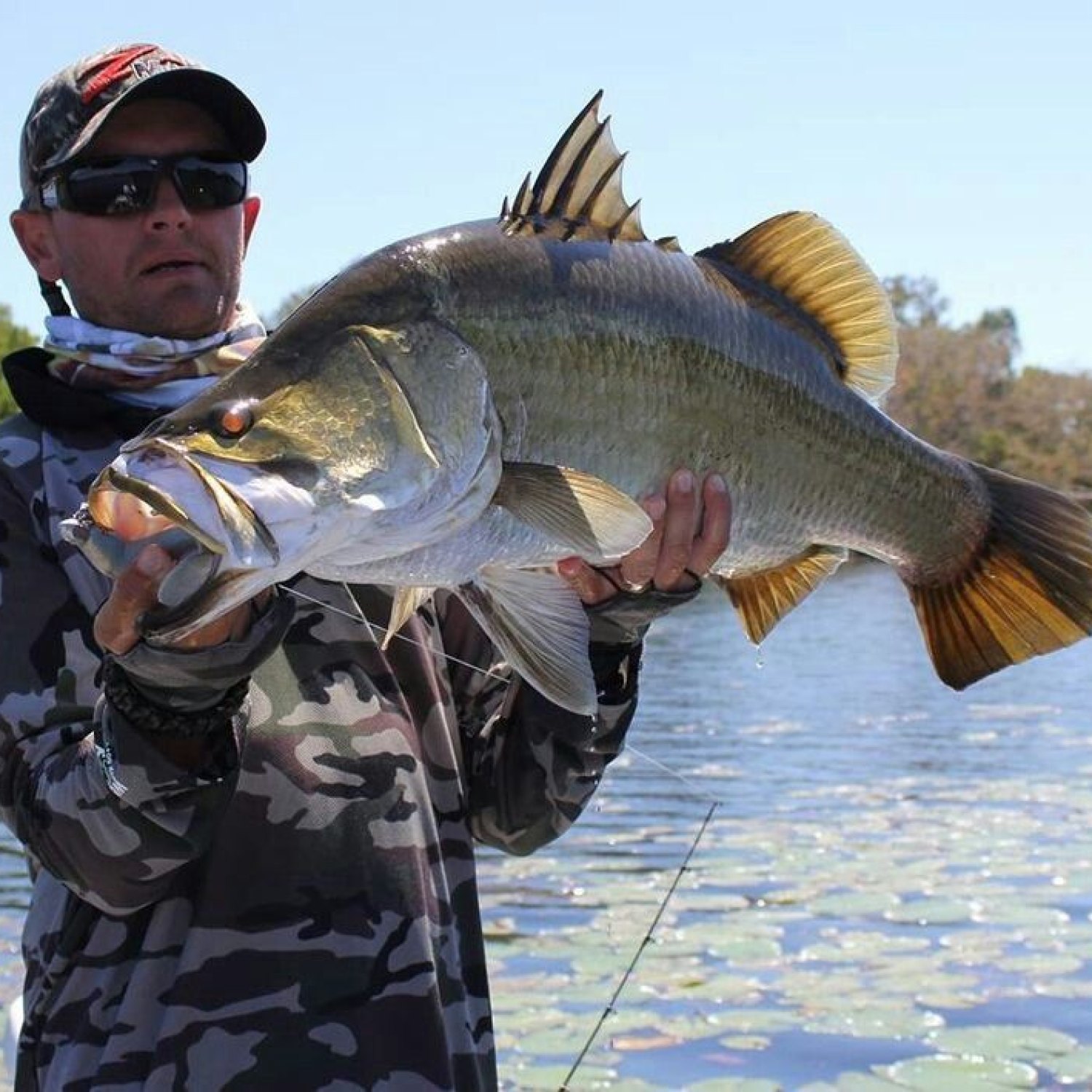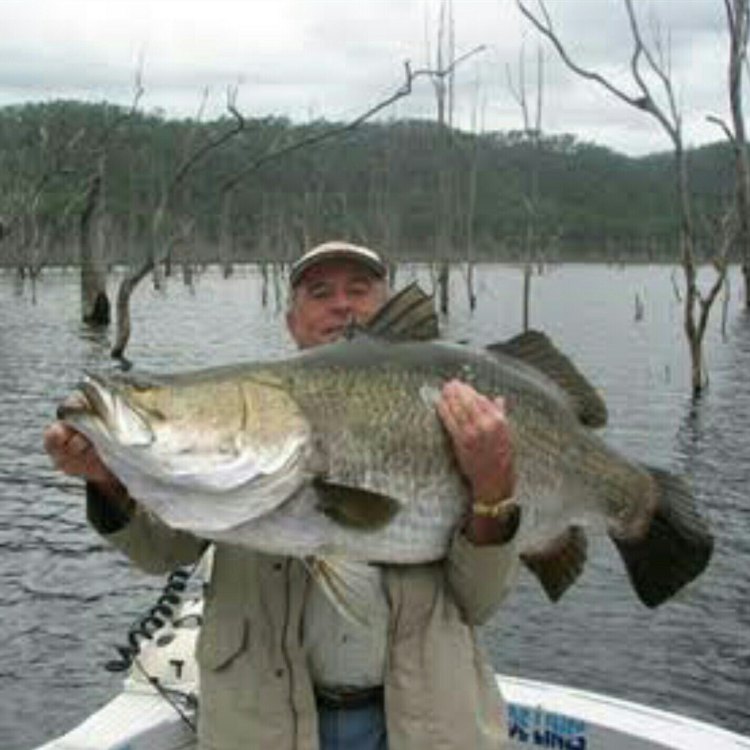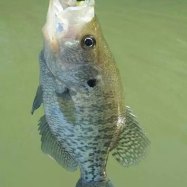
Barramundi Fish
Up to 1.8 meters (6 feet)
The barramundi fish, also known as the Asian seabass, is a popular game fish found in Northern Australia and Southeast Asia. With a sleek and elongated body, it can grow up to 1.8 meters (6 feet) in length and has a large mouth and two dorsal fins. Its scientific family is Latidae. Catch one of these impressive creatures on your next fishing trip! #Barramundi #Fish #Australia #SoutheastAsia
Animal Details Summary:
Common Name: Barramundi Fish
Kingdom: Animalia
Habitat: Brackish and freshwater habitats
Barramundi Fish: An Elusive and Mighty Hunter of the Indo-West Pacific Region
The Indo-West Pacific region is home to a plethora of marine life, with the turquoise waters of the Indian and Pacific oceans teeming with a variety of fish species. Among these is the elusive and mighty Barramundi Fish, scientifically known as Lates calcarifer. This top predator is highly sought after by anglers and prized for its excellent taste, making it a popular game fish. But what makes this fish so special? Let's dive into the fascinating world of the Barramundi Fish and uncover its outstanding features Barramundi Fish.Origin and Distribution
Barramundi Fish is native to the Indo-West Pacific region, specifically found in Australia and Southeast Asia. Their natural habitat includes both brackish and freshwater environments, such as rivers, estuaries, and mangrove swamps. They are known to reside in a variety of aquatic habitats, from coastal lagoons to deep inland lakes.
Physical Characteristics
The Barramundi Fish is a sleek and elongated predator with a large mouth and characteristic elongated body. They can reach lengths of up to 1.8 meters (6 feet), making them one of the largest and most impressive fish species in their range. They have two dorsal fins, with the first being spiny and the second one softer. The coloration of the Barramundi Fish can range from silver to grayish, with dark green to dark brown bands or speckles covering their body.
Hunting Techniques
As carnivorous fish, Barramundi Fish feed on a variety of prey, including crustaceans, smaller fish, and even insects Beefalo. What makes them particularly unique is their hunting technique. They use their large mouth to create a vacuum and suck in their prey, making them swift and efficient hunters. They also have excellent hearing, which helps them detect vibrations in the water to locate their prey.
Barramundi Fish are also known to be opportunistic hunters, making use of their surroundings to their advantage. For example, they can often be seen lurking around logs, mangrove roots, or other structures in the water, waiting for their prey to come their way.
Reproduction and Life Cycle
Barramundi Fish reach sexual maturity at around three to four years of age. They reproduce through external fertilization, with females releasing their eggs into the water, and males fertilizing them. Interestingly, Barramundi Fish have the ability to change sexes, with females transforming into males later in life. This adaptation is rare among fish species and is known as protandrous hermaphroditism.
Once fertilized, the eggs hatch within a day, and the larvae are carried by currents to their preferred habitats. As they grow, they move to brackish or freshwater habitats, where they continue to mature into adults. Their lifespan is estimated to be around 20 years.
Role in the Ecosystem
As an apex predator, Barramundi Fish plays a crucial role in the ecosystem of the Indo-West Pacific region. They help regulate the populations of their prey species, maintaining a healthy balance in the marine environment. Additionally, they are important for a variety of cultural and economic reasons, as they provide food for both humans and other marine animals.
Conservation Status
Due to their popularity among anglers, Barramundi Fish are highly exploited, leading to declining populations in some areas. They are also affected by habitat loss and pollution, which can impact their ability to reproduce and survive. As a result, they are listed as vulnerable by the International Union for Conservation of Nature (IUCN). Efforts are being made to sustainably manage their populations and protect their habitats to ensure their survival for generations to come.
In Conclusion
The Barramundi Fish is a fascinating and magnificent creature, with outstanding features that make it a top predator in the Indo-West Pacific region. From its impressive size to its efficient hunting technique, this fish has captured the imagination of many. However, with its conservation status in jeopardy, it is crucial to understand and appreciate the role these fish play in the marine ecosystem and work towards their sustainable management.
So next time you're in the Indo-West Pacific region, keep an eye out for the elusive Barramundi Fish, and you may just catch a glimpse of this mighty hunter in action.

Barramundi Fish
Animal Details Barramundi Fish - Scientific Name: Lates calcarifer
- Category: Animals B
- Scientific Name: Lates calcarifer
- Common Name: Barramundi Fish
- Kingdom: Animalia
- Phylum: Chordata
- Class: Actinopterygii
- Order: Perciformes
- Family: Latidae
- Habitat: Brackish and freshwater habitats
- Feeding Method: Carnivorous
- Geographical Distribution: Indo-West Pacific region
- Country of Origin: Australia
- Location: Northern Australia, Southeast Asia
- Animal Coloration: Silver or grayish with dark green to dark brown bands or speckles
- Body Shape: Sleek and elongated with a large mouth and two dorsal fins
- Length: Up to 1.8 meters (6 feet)

Barramundi Fish
- Adult Size: Up to 1.5 meters (5 feet)
- Average Lifespan: 10-20 years
- Reproduction: Sexual
- Reproductive Behavior: Spawning
- Sound or Call: Produces grunting and croaking sounds
- Migration Pattern: Some populations exhibit migration behavior
- Social Groups: Solitary or in small groups
- Behavior: Nocturnal
- Threats: Overfishing, habitat loss, pollution
- Conservation Status: Vulnerable
- Impact on Ecosystem: Key species in freshwater and estuarine ecosystems
- Human Use: Commercial and recreational fishing
- Distinctive Features: Large size, silver coloration with dark bands, elongated body
- Interesting Facts: Ability to change sex from male to female, known as hermaphroditism
- Predator: Sharks, crocodiles, larger predatory fish

Lates calcarifer
The Fascinating World of Barramundi Fish: A Key Species in Aquatic Ecosystems
From the serene lakes of Australia to the bustling rivers of Asia, the Barramundi fish, also known as Asian seabass, is a prominent and iconic aquatic species. With an average lifespan of 10-20 years and reaching adult sizes of up to 1.5 meters (5 feet), this species is an integral part of freshwater and estuarine ecosystems. However, despite its importance, the Barramundi fish is facing various threats that have led to its vulnerable conservation status PeaceOfAnimals.Com. In this article, we will dive deep into the captivating features, behaviors, and significance of this magnificent fish.Distinctive Features
One of the most distinctive features of the Barramundi fish is its large size and elongated body. It is considered one of the largest species in the Latidae family, which also includes groupers and snappers. The Barramundi's body is streamlined with a silver coloration, complemented by dark bands running horizontally along its sides. This unique coloration helps the fish to blend in with its surroundings and makes it difficult for predators to spot in the murky waters.
Reproductive Behavior and Interesting Facts
The Barramundi fish undergoes sexual reproduction and reproduce through spawning. During the spawning season, males and females gather in large groups and release their eggs and sperm in open water. Interestingly, the Barramundi have the ability to change sex from male to female, a phenomenon called hermaphroditism. This rare feature allows the species to adapt to changing environmental conditions and continue their reproductive success Bernedoodle.
Migration Pattern and Behavior
While some populations of Barramundi fish exhibit migration behavior, others are known to be more sedentary. The migratory behavior is often influenced by seasonal changes, food availability, and reproductive needs. Studies have shown that the fish undertake long-distance migrations to reach their preferred breeding grounds, and these migrations are critical for the health and survival of the species.
Being a nocturnal species, the Barramundi fish spends most of its day resting in the deeper waters and becomes more active at night. This behavior is not only a survival strategy against their predators but also helps them to conserve energy and maintain their body temperature.
Human Use and Threats
The Barramundi fish has been commercially and recreationally fished for centuries. In fact, it is considered a prized catches among anglers due to its size and fighting ability. However, the rapid increase in demand for this fish has led to overfishing, which is a significant threat to their population. Overfishing can result in reduced genetic diversity, affecting their reproductive success and survival rates.
Apart from overfishing, the Barramundi fish also faces threats from habitat loss and pollution. As humans continue to expand their activities, it has led to the destruction of wetlands and estuaries, which are essential habitats for the species. Pollution, such as plastic waste and chemicals, also poses a significant threat to their survival.
Conservation Status and Impact on Ecosystem
The Barramundi fish is classified as a vulnerable species by the International Union for Conservation of Nature (IUCN). This means that the species is facing a high risk of extinction in the wild, and immediate conservation efforts are needed to prevent their decline. As a key species in freshwater and estuarine ecosystems, the loss of Barramundi fish can have severe consequences on the entire ecosystem. They help to maintain the balance of species, maintain water quality, and are a crucial part of the food web.
Barramundi Fish: A Species Worth Protecting
Despite facing various threats, there is still hope for the Barramundi fish. Several measures have been implemented to protect and conserve the species, such as the creation of marine reserves and restrictions on fishing techniques. Research is also being conducted to understand their biology, behavior, and the effects of human activities on their population. By implementing sustainable fishing practices and protecting their habitats, we can ensure the survival of this important species.Moreover, efforts are being made to raise awareness about the significance of Barramundi fish in aquatic ecosystems. Education and outreach programs can help to change the perception of the fish from being just a prized catch to an essential part of our environment.
In Conclusion
In conclusion, the Barramundi fish is a remarkable species that deserves our attention and protection. From being able to change sex to playing a critical role in aquatic ecosystems, this fish is truly fascinating. However, with the increasing threats of overfishing, habitat loss, and pollution, their population is rapidly declining. It is our responsibility to take action and implement effective conservation measures to ensure the survival of this magnificent species. Only then can we truly appreciate and admire the beauty of the Barramundi fish and its importance in the vast and diverse aquatic world.

Barramundi Fish: An Elusive and Mighty Hunter of the Indo-West Pacific Region
Disclaimer: The content provided is for informational purposes only. We cannot guarantee the accuracy of the information on this page 100%. All information provided here may change without prior notice.












